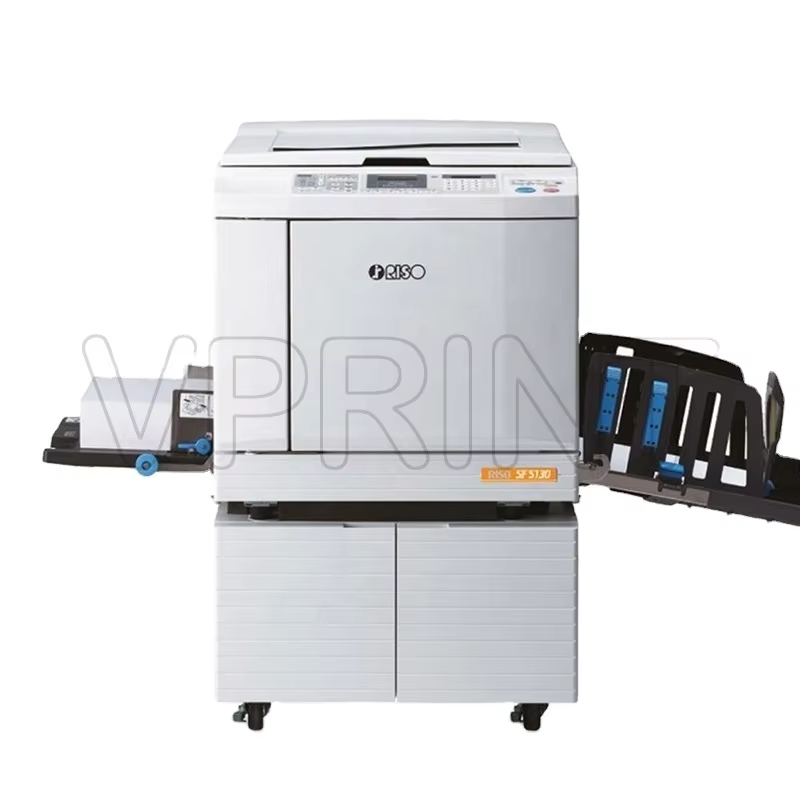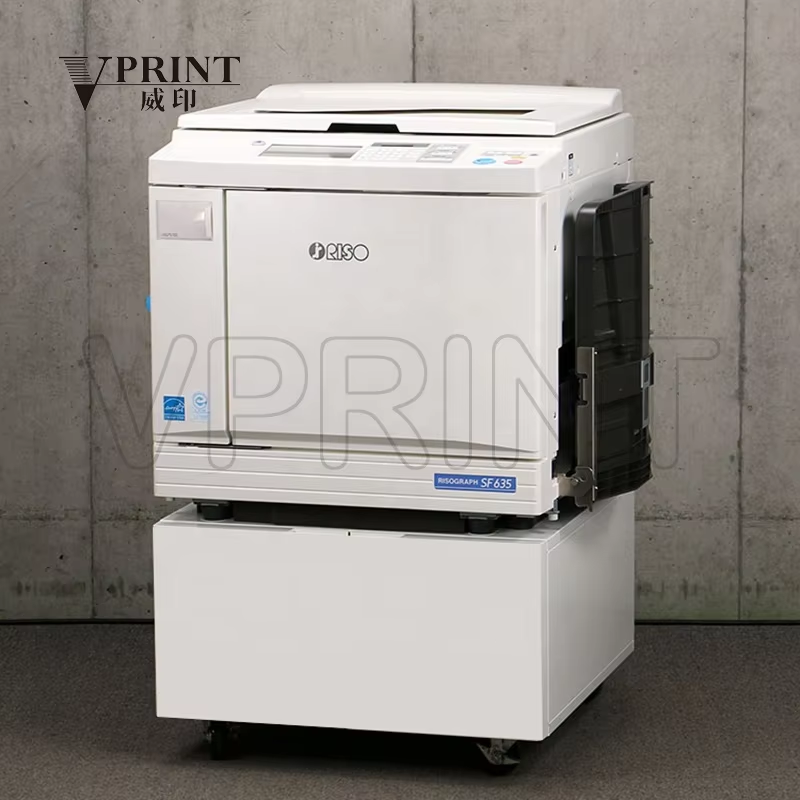केबल र हर्नेसको भूमिकाको प्रतिलिपि गर्ने मशीन संचालन दक्षतामा राखरखाव
नियमित सेवा प्रदान गर्नुको महत्व डाउनटाइमलाई घटाउनु
डुप्लिकेटरहरूको नियमित सेवा गर्नु अनिच्छित मेसिन खराबीलाई घटाउने सबैभन्दा राम्रो तरिका हो जुन सामान्यतया उत्पादन डाउनटाइममा परिणत हुन्छ। प्रिएक्टिभ रखरखाव प्रथाहरूले डाउनटाइमलाई ३०% सम्म कम गर्न सक्छ, जसले गर्दा संचालन दक्षता सुधार हुन्छ। निवारक रखरखाव मार्फत संगठनहरूले सम्भावित समस्याहरूलाई ठूलो समस्यामा विकसित हुनबाट रोक्न सक्छन् र आफ्नो दैनिक संचालनलाई बाधित गर्नबाट जोग्न सक्छन्। यो प्रो-एक्टिभ रोकथाम रणनीति उपकरणहरूलाई उत्तम अवस्थामा राख्न मद्दत गर्दछ र उत्पादकता र सेवा विश्वसनीयता बढाउँछ।
रोकथाम देखभालले प्रिन्टिङ त्रुटिहरू कसरी घटाउँछ
रोकथाम यांत्रिकताले प्रिन्टिङ त्रुटिहरू कम गर्नेछ र सुधारिएको गुणस्तर नियन्त्रण प्रक्रियाले अझै बढी उत्पादकता सुनिश्चित गर्नेछ। समयमै गरिएमा, यी क्यालिब्रेसन परिवर्तनहरू, सफाइ प्रक्रियाहरू र निरीक्षणहरूले डुप्लिकेटरहरूलाई ठप्प नभएर सजिलै संचालन गर्न अनुमति दिनेछ। नियमित रोकथाम मर्मतसम्भारमा संलग्न व्यवसायहरूले वास्तवमा यो समाचार दिएका छन् कि उनीहरूको प्रिन्टिङ त्रुटिहरू २०% कम छ, कम्पनीहरूलाई सजिलै संचालन गर्न र आफ्नो उच्च गुणस्तरको उत्पादन बनाए राख्न सहयोग गर्दछ। यस्तै समयमा, रोकथाम मर्मतले प्रिन्ट त्रुटिहरूको संख्या कम गर्नुको साथै उत्पादनको समस्या-मुक्त वातावरण सुनिश्चित गर्दछ।
निरन्तर उत्पादन गुणस्तर सुनिश्चित गर्न मर्मतको भूमिका
उच्च गुणस्तरको प्रिन्ट गर्न सक्ने क्षमता भएका प्रिन्टरहरूको निरन्तरता कायम राख्न राम्रो सेवा र राखरखाव महत्वपूर्ण छ। भागहरूलाई उत्तम स्थितिमा राखेर मशीनका भागहरूले सँगै काम गरी विश्वसनीय प्रिन्ट गुणस्तर सुनिश्चित गर्न मद्दत गर्छ। राम्रो ढंगले सेवा गरिएका मेसिनहरूले खराब रूपमा सञ्चालित मेसिनको तुलनामा ४०% सम्म बढी प्रयोग योग्य प्रतिलिपि उत्पादन गर्न सक्ने भएकाले नियमित रूपमा मर्मतको प्राथमिकता दिएर कम्पनीहरूले लागत कटौती गर्न सक्छन् र ब्रान्डको छवि उच्च राख्न मद्दत गर्ने गरी प्रिन्ट गुणस्तर सुधार्न सक्छन्।
अरिजिनल इक्विपमेन्ट म्यानुफ्याक्चरर (OEM) पार्ट्स र दीर्घकालीन प्रतिलिपि गर्ने मशीन प्रदर्शन
किन OEM घटकहरूले मेसिनको आयु बढाउँछ
मेशिन डिजाइनमा सँगै मिल्ने र सजिलो प्रयोगको कारणले ओइएम भागहरूले डुप्लिकेटरको आयु बढाउँछ। यी भागहरू निर्माता मानकहरूलाई पूरा गर्नका लागि डिजाइन गरिएका हुन्छन् र तपाईंको खपत यन्त्रहरूमा हुने घिस्रोलाई न्यूनीकरण गर्दछ। प्रमुख कम्पनीहरूको विश्लेषणबाट सुझाव दिइएको छ कि OEM आपूर्ति प्रयोग गर्दा डुप्लिकेटरको आयु लगभग 30% लामो हुन्छ र यन्त्रलाई सञ्चालन लोडलाई सहन सक्ने क्रममा बनाइन्छ। यन्त्रको गुणस्तरलाई यसका भागहरूद्वारा संरक्षित राखेर, तिनीहरूले निरन्तर प्रदर्शन प्रदान गर्दछन् र व्यवसायलाई राम्रोसँग सञ्चालन गर्न मद्दत गर्दछन्, यसलाई दीर्घकालीन सञ्चालन गर्न सक्ने क्षमता बनाए राख्दछ।
तेस्रो पक्षका प्रतिस्थापन भागहरू प्रयोग गर्ने जोखिमहरू
यद्यपि तेस्रो पक्षका विकल्पहरूले अगाडि पैसा बचत गर्न सक्छन्, तर ती कम्पोनेन्टहरूले प्रयोगकर्ताहरूलाई नक्कली प्रदर्शन र सुरक्षा जोखिमहरूमा पनि पार्दछन्। आवश्यकता भन्दा कम गुणस्तरीय कम्पोनेन्ट र मेसिन खराब हुने। प्रमाणहरूले देखाएको छ कि तेस्रो पक्षका कम्पोनेन्टहरू प्रयोग गर्ने संगठनहरूमध्ये 40% ले बढ्दो खराबीको संख्याका कारण राखरखाव खर्च र डाउनटाइममा वृद्धि देखेका छन्। यी घटिया कम्पोनेन्टहरूले उपकरणमा समय भन्दा पहिले खराबी वा अन्य क्षति निम्त्याउन सक्छ, जसले निरन्तर विश्वसनीयताको प्रश्न उठाउँछ र प्रतिस्थापनको सम्भावित आवृत्तिका कारण सञ्चालन लागतमा वृद्धि हुन्छ।
राखरखाव छनौटका वारेन्टी निहितार्थ
प्रतिलिपि गर्ने मशीन वारेन्टी सुरक्षा मुख्यतया OEM भागहरूको प्रयोगमा निर्भर गर्दछ। धेरै वारेन्टीले OEM भागहरू प्रयोग गर्नुपर्ने अनिवार्य शर्त राख्दछन्, जसले यस्तो उपकरणमा भएको पूँजी लगानीको रक्षा गर्दछ। कानूनी स्रोतहरूले संकेत गरेका छन् कि OEM बाहेकका भागहरू खरीद गर्ने वा OEM मापदण्डहरूभन्दा बाहिर सञ्चालन हुने मेसिन प्रयोग गर्ने व्यवसायहरूको वारेन्टी रद्द हुन सक्छ र मर्मत खर्च तिर्नुपर्न सक्छ। वारेन्टी समाप्त भएपछि पनि OEM भागहरूको प्रयोगले मेसिनको निरन्तरता बनाए राख्दछ र तपाईंको लगानीको रक्षा गर्दछ किनभने यी भागहरू मेसिनको ठीक आवश्यकता अनुसार डिजाइन गरिएका हुन्छन्, जसले मेसिनको स्थायित्व र अधिकतम कार्यक्षमतालाई सुनिश्चित गर्दछ।
रोकथाम मर्मतको लागत-लाभ विश्लेषण प्रतिलिपि गर्ने मशीन फरक
प्रतिक्रियाशील र पूर्वानुमानात्मक मर्मतको लागतको तुलना
तपाईंको डुप्लिकेटरको सम्बन्धमा, प्रतिक्रियाशील तरिकाको तुलनामा पहल लिएर मर्मतसम्भार गर्नु आर्थिक रूपमा बुद्धिमानी हो। प्रतिक्रियाशील मर्मतसम्भारले अनियोजित लागतहरूलाई जन्म दिन सक्छ जुन नियोजित मर्मतसम्भारको लागतको तुलनामा 2-3 गुणा बढी हुन सक्छ। रोकथाम मर्मतसम्भारलाई समावेश गरेर कारोबारहरूले आफ्ना बजेटहरूमाथि सुधारिएको नियन्त्रण र खर्चको भविष्यवाणी गर्न सक्छन्, जुन प्रतिस्पर्धात्मक किनार हो। सांख्यिकीय विश्लेषणहरूले देखाएको छ कि संगठनहरूले आफ्ना सुविधाहरूको सुरक्षा र सुरक्षा दिने काम गरेर मर्मत लागतमा ठूलो बचत गर्न सक्छन् भन्दा उनीहरूको मर्मत वा प्रतिस्थापन गर्ने काम गर्दा, र राम्रो ROI लगानी गर्न सक्छन्।
क्यालिब्रेटेड सिस्टम मार्फत ऊर्जा दक्षता लाभ
तपाईंले डुप्लिकेटरलाई सही तरिकामा राखेर तपाईं मर्मत खर्चबाट बच्नुहुन्छ, साथै ऊर्जा पनि बचत गर्नुहुन्छ। ठीक प्रकारको व्यवस्थापन भएका सिस्टमहरू अधिक कुशलतापूर्वक काम गर्दछन्, कम ऊर्जा प्रयोग गर्दछन् र कहिलेकाहीँ तपाईंको ऊर्जा खर्च २०% सम्म कम हुन्छ। औसत बचत मेशिनको आयुसम्मको आधारमा हुन्छ जसमा नियमित क्यालिब्रेसनले ठूलो भूमिका खेल्छ। नियमित निरीक्षण र क्यालिब्रेसनले मात्र धन बचत गर्दैन बरु सञ्चालनको कुल कार्बन लागत घटाएर स्थायित्वलाई पनि बढावा दिन्छ।
उचित सम्हालमार्फत सेवा अन्तराल बढाउनु
रोकथाम रखरखाव तपाईंको डुप्लिकेटरबाट लामो सेवा जीवन प्राप्त गर्न र मर्मतका आवश्यकताहरू लम्ब्याउने कामको महत्वपूर्ण भाग हो। निश्चित रूपमा, जो कम्पनीहरूले कडा सेवा अनुसूचीमा लगानी गर्छन् उनीहरूले सेवा कलहरूको आवृत्ति घटाएर आधा बनाउन सक्छन्। यो विस्तारित जीवनले दुवै सञ्चालन गर्ने स्थायित्व र कम डाउनटाइम ल्याउँछ जसले गर्दा सञ्चालन अधिक उत्पादक बन्छ। व्यवसायहरूमा अवरोधहरू घटाउनाले व्यवसायहरूलाई लामो समयसम्म व्यवसायिक सञ्चालनमा आगामी योजनाका साथ अघि बढ्न र उत्पादकता अनुकूलन गर्न मद्दत पुर्याउँछ।
सामान्य डुप्लिकेटर समस्याहरूको समाधान गर्नु
कागज खाने समस्याको निदान गर्नु
कपि प्रिन्टरहरूसँग सामना गर्ने एउटा सामान्य समस्या यो हो कि कागज अब उचित रूपमा खुवाइएन, या त रबर रोलरहरू घसिएका हुन्छन् वा आन्तरिक भागहरू मिसम्याच भएका हुन्छन्। यी सामान्य समस्याहरूले खराबी नघटाउनुअघि नै निरीक्षण गर्ने काममा महत्वपूर्ण रहन्छ। निर्माण फरक उद्योगको रूपमा पनि चिनिन्छ- वेब र लिथोग्राफी क्षेत्रका केही विशेषज्ञहरूले भन्छन् कि क्यालिब्रेसनले कागज खुवाउने समस्याहरूको लगभग 75% सुधार गर्न सकिन्छ। व्यवसायहरूले नियमित रूपमा जाँच गरेर उपकरणको विश्वसनीयता धेरै सुधार्न र बन्द रहने समय न्यूनतम पार्न सक्छन्।
ठाँट चिन्हहरू र प्रिन्ट दोषहरूको सम्बोधन गर्नु
धारी र स्मियरहरू पृष्ठमा अवांछित चिन्हहरू वा धारीहरू केहि कुराहरूले पृष्ठमा धारीहरू हुन सक्छन् - मैलो प्रिन्ट हेड, निकृष्ट गुणस्तरको स्याहारु, आदि। उत्कृष्ट प्रिन्ट गुणस्तरको लागि नियमित रूपमा सफाई गर्नु नियमित रूपमा कायम राख्नुपर्ने कार्यक्रमको भाग हो। उद्योगका मापदण्डहरूले देखाएको छ कि नियमित रूपमा राखिएको स्थितिमा 50% भन्दा बढी प्रिन्ट दोषहरू कम हुन सक्छ। यस प्रकारको सक्रिय तरिकामा काम गरेर मुद्रित आउटपुटको मानक उच्च स्तरमा बनाइएको रहन्छ, जसले ग्राहक सन्तुष्टि बढाउँछ र पुन: प्रिन्ट गर्ने संख्या कम हुन्छ।
ओभरहिटिङको चेतावनी समाधान गर्नु
डुप्लिकेटरहरूमा अत्यधिक तापक्रमचेतावनीले भन्छ कि सम्भवतः पवनच्छड गर्ने समस्या वा धूलो जम्मा हुने समस्या हुन सक्छ। नियमित सफाई र निरीक्षण गरेर यस्तो चेतावनीबाट बच्न सकिन्छ र तपाईंको सिस्टम सहीसँग चलिरहेको छ भन्ना सुनिश्चित गर्न सकिन्छ। सांख्यिकीय तथ्यले देखाउँछ कि यस्तो चेतावनीको व्यवस्थित ढंगले सामना गर्नुले तापक्रमका कारणले हुने 90 प्रतिशत आउटेजबाट बच्न मद्दत मिल्छ। रोकथामात्मक जाँचले उपकरणलाई उच्चतम दक्षताका साथ काम गर्दै राख्न मद्दत गर्छ र महँगो मर्मतका आवश्यकताबाट बच्न मद्दत मिल्छ।

व्यापक रखरखाव अनुसूचीको कार्यान्वयन
तपाईंको उपकरणको लामो आयु र क्षमता बढाने मा रोकथाम मर्मत सबैभन्दा महत्वपूर्ण हुन्छ। संरचित जाँच सूचीहरू सफलताको मार्ग हो। दैनिक, साप्ताहिक र मासिक सेवा आवश्यकताहरू निर्धारण गर्नाले केहि पनि छुट्ने सम्भावना हुँदैन। यदि हातमा प्रयोग हुने की डुप्लिकेटरमा पहिरनको मूल्याङ्कन गर्ने तरिका थाहा छैन भने तपाईंले दैनिक रूपमा अत्यधिक पहिरनको जाँच गर्न सक्नुहुन्छ। अनुकूल अभ्यासले यी कार्यहरूको लागि विशिष्ट समयावधि तय गर्नुपर्ने सुझाव दिन्छ ताकि मर्मतको सबैभन्दा राम्रो उपयोग र सबै प्रणालीको खराबी बाट बच्न सकियोस्।
उत्पादकता अनुकूलन गर्नका लागि मर्मत कार्यक्रम र उत्पादन अनुसूचीको सम्बन्ध बुझ्नु आवश्यक छ। उत्पादन योजनामा मर्मत कार्य समावेश गरेर हामी उत्पादन र क्षमता बनाए राख्न सक्छौं। प्रकरण अध्ययनले पुष्टि गरेको छ कि यस्तो एकीकरणले उत्पादकता 15% सम्म बढाउन सक्छ। मर्मत कार्यहरूलाई उत्पादन चलानसँग चिकनी ढंगले एकीकृत गर्नु दुवै मर्मत प्रक्रिया र उत्पादन पथको लागि उत्पादन घटाइदिने जोखिमलाई कम गर्ने तरिका हो।
मौलिक समस्या निवारणको लागि कर्मचारी प्रशिक्षणमा लगानी एउटा रणनीतिक निर्णय हो जसले डाउनटाइमलाई कम गर्न सक्छ। कर्मचारीहरूलाई कुशलतापूर्वक साना समस्याहरू समाधान गर्न सक्षम बनाएर, कम्पनीहरूले उत्पादकत्वमा आउन सक्ने सम्भावित बाधाहरू हटाउन सक्छन्। यसको साथै, व्यावसायिक अनुमानको आधारमा, प्रशिक्षित कर्मचारी भएका कम्पनीहरूले त्रुटि-सम्बन्धित उत्पादन बन्द हुँदा ३०% सम्म कम डाउनटाइम अनुभव गर्छन्। यसले प्रयोगकर्ताहरूको समय बचत गर्ने छैन मात्र, तर कर्मचारीहरूमा रोकथामको रखरखाव दृष्टिकोण विकसित गर्दछ जसले गर्दा डुप्लिकेटरका समस्याहरू समयमै समाधान गर्न सकिन्छ।
डुप्लिकेटर रखरखावलाई अनुकूलित गर्ने तरिकाहरूको बारेमा थप जानकारीको लागि, यस प्रक्रियामा सहयोग गर्ने उत्पादनहरू सहित , हाम्रो वेबसाइट मा भ्रमण गर्नुहोस्। यहाँ हामी थप संसाधनहरू प्रदान गर्छौं र देखाउँछौं कि प्रभावकारी रखरखाव अनुसूची र प्रशिक्षणले तपाईंको संचालनात्मक कार्यप्रवाहलाई कसरी सुधार्न सक्छ।
FAQ खण्ड
डुप्लिकेटरहरूका लागि नियमित सेवा रखरखाव किन महत्वपूर्ण छ?
नियमित सेवा रखरखावले अप्रत्याशित असफलताहरूलाई घटाउँछ, डाउनटाइमलाई ३०% सम्म कम गर्दछ, र चिकनी सञ्चालन सुनिश्चित गर्दछ।
रोकथाम देखभालले प्रिन्टिङ त्रुटीमा कसरी असर गर्छ?
यो प्रिन्टिङ त्रुटीलाई २०% सम्म कम गर्छ, गुणस्तर नियन्त्रणलाई सजिलो बनाउँछ र निर्बाध उत्पादन कार्यप्रवाह सुनिश्चित गर्छ।
असल मेसिन भागहरू प्रयोग गर्ने फाइदाहरू के हुन्?
असल मेसिन भागहरूले मेसिनको आयु बढाउँछ, घिस्रो कम गर्छ र साथै निरन्तर सञ्चालन दक्षतालाई समर्थन गर्दछ।
तेस्रो पक्षका प्रतिस्थापन भागहरू प्रयोग गर्दा के-के जोखिमहरू हुन्छन्?
तेस्रो पक्षका भागहरू प्रयोग गर्दा अक्सर ठप हुने, मर्मत खर्च बढी हुने र कार्यात्मक व्यवधान जस्ता समस्या आउने गर्छन्।
मर्मतसम्भारले वारेन्टी शर्तहरूमा कसरी असर गर्छ?
वारेन्टीको वैधता कायम राख्न असल मेसिन भागहरू प्रयोग गर्नु आवश्यक हुन्छ, जसले वारेन्टी रद्द हुँदा हुने महँगो मर्मत खर्चबाट बच्न मद्दत गर्छ।
विषय सूची
- केबल र हर्नेसको भूमिकाको प्रतिलिपि गर्ने मशीन संचालन दक्षतामा राखरखाव
- अरिजिनल इक्विपमेन्ट म्यानुफ्याक्चरर (OEM) पार्ट्स र दीर्घकालीन प्रतिलिपि गर्ने मशीन प्रदर्शन
- रोकथाम मर्मतको लागत-लाभ विश्लेषण प्रतिलिपि गर्ने मशीन फरक
- सामान्य डुप्लिकेटर समस्याहरूको समाधान गर्नु
- व्यापक रखरखाव अनुसूचीको कार्यान्वयन

